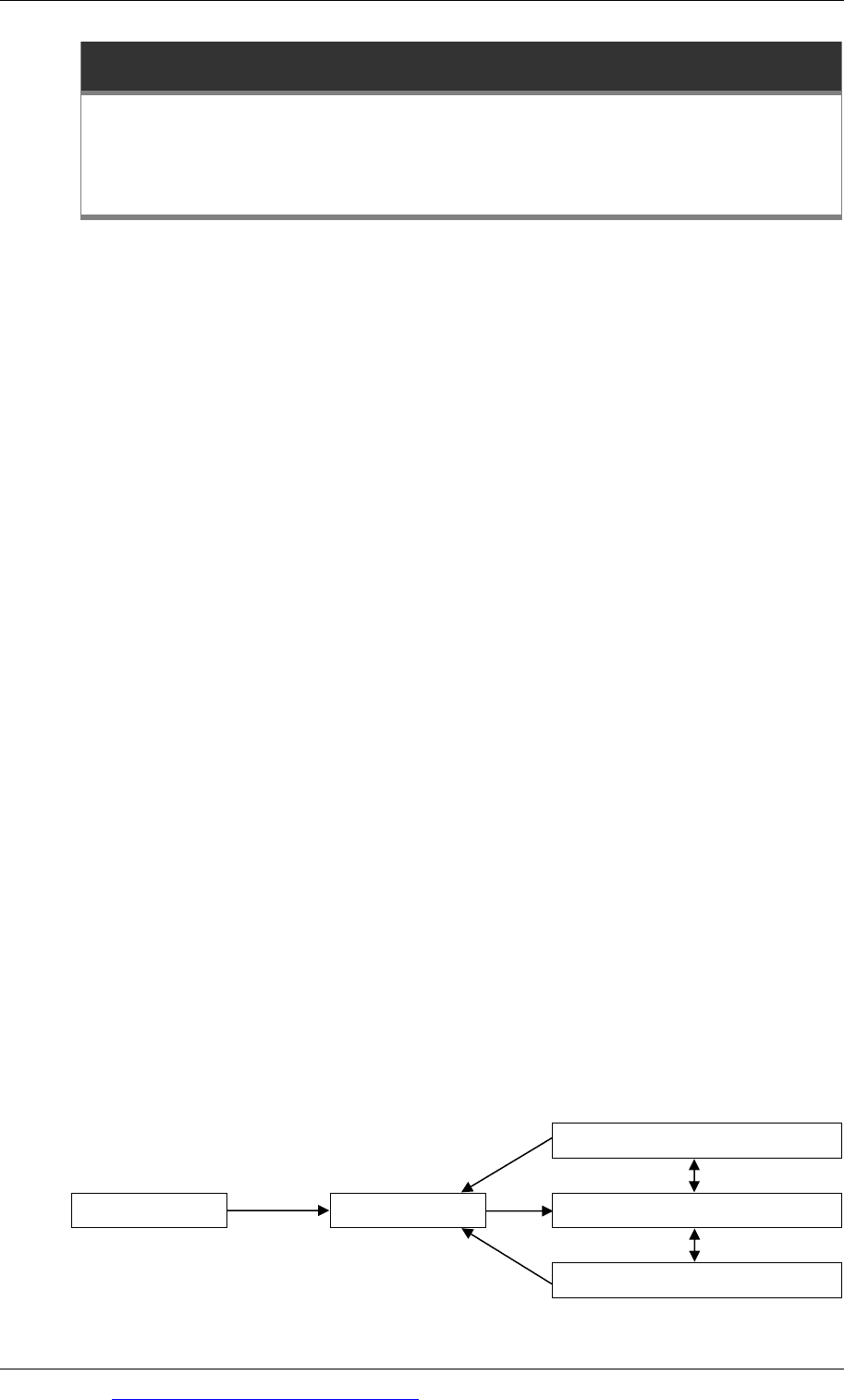ACCA P3 Business Analysis - 2010 - Study text - Emile Woolf Publishing
Подождите немного. Документ загружается.


Chapter 16: Leadership and human resources management
© EWP Go to www.emilewoolfpublishing.com for Q/As, Notes & Study Guides 405
seen as an investment, not a cost. Johnson, Scholes and Whittington have
commented: ‘Since the early 1990s, the resource-based view of strategy has become
highly influential.’
They also comment that entities should make full use of employees’ knowledge in
order to develop emergent strategies. ‘If employers can only see strategies in terms
of deliberate planning, they not only risk that such strategies go unrealised, but they
also waste the learning that can emerge from their employees.’
Leadership and the management and development of human resources affect all
aspects of business s strategy. The examiner for Business Strategy has commented:
‘People issues will be inevitable in most questions set in this examination.
Candidates must remember to explore … this perspective.’
Human Resource Development and change management
Business strategy development calls for change. The culture of an entity might resist
change, or there might be a culture of welcoming change in order to move the
business forward.
Change management was discussed in an earlier chapter. You should be aware of
the close link between the management and development of employees and other
human resources is related to the management of change.
1.2 A brief history of leadership theory
Leadership is an important management skill. It can be defined as an inter-personal
influence directed towards the achievements of a goal or objective. An effective
leader is someone who leads other people towards the achievement of a goal. An
effective manager is therefore a person who is able to lead other people towards the
successful achievement of the entity’s objectives. He or she gets other people to do
whatever helps the entity to achieve its objectives.
‘Other people’ are the individuals that the leader works with, including his or her
‘subordinates’ in an entity with a hierarchical authority structure. However, ‘other
people’ may also be members of a project team, individuals to whom work is
outsourced, and individuals in other parts of the entity.
Leadership theory is concerned with the qualities that make someone an effective
leader. There have been different views about leadership and the qualities of an
effective leader, especially for managing change and implementing business
strategies. ‘Whoever is in the position of managing change needs to consider the
style of management they adopt’ (Johnson, Scholes and Whittington).
There are several theories about what makes a good leader:
Trait theory
Style based theory
Contingency based theory
Activity based theory
Strategic visionary leadership.

Paper P3: Business analysis
406 Go to www.emilewoolfpublishing.com for Q/As, Notes & Study Guides © EWP
Trait theory
Trait theory assumes that there are certain qualities or traits in an individual that
makes him (or her) a ‘born leader’. Leaders are born, not made. The theory takes the
view that if a person possesses the traits required for leadership, he or she will be
able to provide effective leadership in any type of situation.
The traits required for good leadership might be physical, intellectual or personal
qualities. They might include physical vitality, skill in dealing with people, an eager
ness to accept responsibility, an ability to motivate people, courage and resolution, a
need for achievement, decisiveness, self-confidence, trustworthiness, assertiveness
and an ability to adapt and show flexibility.
The list of traits can be very long. A problem with trait theory is that not many
individuals show all the traits of effective leadership, so how many are needed to be
effective? It is also recognised that some leadership traits are more relevant in some
situations than in others.
Trait theory is therefore of only limited value in identifying what is needed to
provide effective business leadership.
Style theory (behavioural theory)
Style theory or behavioural theory is based on an analysis of how leaders behave
rather than the traits or qualities they possess. It is suggested that the effectiveness
of a leader depends on the style of leadership and how the leader behaves,
especially towards subordinates or team members. It is the style of management
that matters.
Early theorists who put forward a behavioural theory of leadership identified some
or all of the following styles:
Concern for the task. These leaders focus on the achievement of specific
objectives. They concentrate on the successful achievement of goals, and
organising people to achieve a high level of productivity.
Concern for people. These leaders treat their subordinates or team members as
people, show concern for their interests and problems and try to develop them
in the work that they do. People are not simply units of resource that are paid to
achieve a business purpose. By showing concern for people, it should be possible
to develop them into more effective and efficient workers.
Directive leadership. This style of leadership is based on telling people what to
do and making decisions for other people to act on. Subordinates or team
members are expected to do what they are told.
Participative leadership. These leaders try to encourage participation in
decision-making by subordinates or team members. The view is that by
involving others on decision-making, they will be motivated more effectively
and will therefore perform better in their work. Motivated individuals are much
more likely to work harder to achieve clear work objectives.
A leader might be autocratic or democratic, participative or bureaucratic, people-
orientated or task orientated. There is an appropriate style for each work situation.

Chapter 16: Leadership and human resources management
© EWP Go to www.emilewoolfpublishing.com for Q/As, Notes & Study Guides 407
Behavioural theory suggests that leaders can be trained in the appropriate style to
use.
Situational theory (contingency theory)
Situational theory or contingency theory is a development from behavioural theory.
It considers the situation in which leadership is exercised. The theory is that the
most suitable form of leadership differs according to the situation. The most
effective form of leadership in one situation is not the most effective form in a
different situation.
Situational theory or contingency theory suggests that there is no single set of
characteristics that make a good leader. If a manager is in charge of people who
expect to be closely managed, then an autocratic style might be appropriate. With
other employees that style would not work and a more participative style would
need to be adopted.
For example, a leader may need to be more directive in situations where a quick
decision is needed and where people are used to being told what to do. (The armed
forces are an obvious example where such situations arise regularly.)
Hersey and Blanchard (1977) identified four different leadership styles, and
suggested that one style was more appropriate than the others for a given situation.
The four styles they identified were as follows.
Telling. This style gives high emphasis to the task and getting the task done, and
gives low emphasis to relationships and people. This style is characterised by
giving directions to subordinates and defining the roles of subordinates and the
goals that the work group should achieve. This style might be appropriate for
dealing with new staff, or where the work must be completed quickly or
urgently, or where the work is manual or repetitive (and employee skills are not
so important).
Selling. This style gives high emphasis to the task and getting the task done, and
also gives high emphasis to relationships and people. The leader gives most of
the directions, but also makes an attempt to get subordinates to ‘buy into’ the
task. The leader acts as a ‘coach’, similar to a sports coach. This style might be
appropriate where employees are motivated and willing to do well, but lack the
ability or maturity, and therefore need guidance from the leader.
Participating. This style gives low emphasis to the task and getting the task
done, but gives high emphasis to relationships and people. The leadership style
is focused on facilitating and communicating. Subordinates are given a great
deal of encouragement, and use their abilities to get the work done. This style
might be appropriate when subordinates have the ability to get the work done,
but are insecure or unwilling.
Delegating. This style gives low emphasis to the task and getting the task done,
and low emphasis to relationships and people. The leader identifies the problem
or objective, but the subordinates are given the responsibility for carrying out
their tasks so that the problem is resolved or the objective is achieved. This form
of leadership style is well-suited to employees with a high degree of
competence. They know what to do and have the motivation to do it.

Paper P3: Business analysis
408 Go to www.emilewoolfpublishing.com for Q/As, Notes & Study Guides © EWP
Critics of situational theory argue that not enough attention is given to cultural
differences, and how the culture of the work group also affects the most suitable
leadership style. Another criticism, which is also a criticism of trait theory, is that no
allowance is made for differences in the gender of leaders. Some theorists argue that
successful female leaders are often more caring and sensitive than successful male
leaders. The situation alone does not determine what leadership style is best.
Activity based leadership theories
These theories state that it is what a manager does that makes him (or her) a good
leader. Adair’s action-centred leadership theory suggests that a leader has to give
attention to task needs, individual needs and group needs. An effective leader is one
who can give appropriate attention to each of the three factors – which might be in
conflict.
1.3 Transactional and transformational leadership
Burns (1977) made a distinction between transactional and transformational
leadership.
Transactional leaders ‘approach their followers with an eye to trading one thing
for another.’
Transformational leaders seek to appeal to the better nature of their followers,
change them for the better and ‘move them toward higher and more universal
needs and purposes’. A transformational leader is an individual who seeks to
change people
The main differences between transactional and transformational leaders are set out
below.
Transactional leader Transformational leader
Recognises what an employee wants from work
and tries to ensure that the employee gets what
he wants provided that his performance justifies it.
Raises the level of awareness of an employee
about the significance of what the employee’s
work should be trying to achieve, and also
makes the employee more aware of ways of
how these achievements should be reached.
Exchanges rewards for the employee’s effort (and
performance).
Encourages the individual to put self-interest to
one side for the sake of the team and the entity
as a whole.
Responds to the employee’s immediate self-
interests, if this will ensure that the work gets
done.
The leader transforms the employee into
someone who wants more from work. The
employee is encouraged to move towards the
highest levels of the Maslow hierarchy of needs.
1.4 The leader as a strategic visionary
Some writers on management and leadership have argued that the traditional views
on effective leadership are not appropriate for ‘learning organisations’.

Chapter 16: Leadership and human resources management
© EWP Go to www.emilewoolfpublishing.com for Q/As, Notes & Study Guides 409
A learning organisation is an entity in which individuals are continually learning
and finding new ways to help the entity achieve its objectives. Individuals in a
learning organisation are capable of innovative thinking. They are also able to see
the ‘bigger picture’ and understand what the entity is trying to achieve.
Their ability to innovate and change comes from their commitment to perform well
in their work and to continue learning.
Peter Senge (1990) has argued that leaders in a learning organisation are ‘strategic
visionaries’. They have a clear vision about what the entity is trying to achieve, and
they are able to convey their vision to the people that they work with. Leaders who
are strategic visionaries are able to get other people to ‘understand complexity,
clarify vision and improve shared mental models – that is, they are responsible for
learning.’
A leader with strategic vision:
helps other people to understand the purpose of their work and gives them a
vision of what they are trying to achieve
enables others to improve their learning continually so that they can deal
constructively with all the problems they face in their work
encourages other people to share the vision, and work towards its achievement.

Paper P3: Business analysis
410 Go to www.emilewoolfpublishing.com for Q/As, Notes & Study Guides © EWP
Human resources management
The importance ofhumanresourcemanagement
The objectivesofhumanresourcestrategy
Human resourceplanning
2 Human resources management
2.1 The importance of human resource management
Human resources are a key resource. The success of a business entity depends on
the skills and experience of its human resources. A critical success factor for a
business entity is to have sufficient human resources with the necessary skills. Top-
quality performance comes from recruiting the best people, using them effectively
and giving them an interest in their work performance. Operational and strategic
success therefore depends on:
recruiting suitable employees and developing their skills and knowledge
managing employees effectively, and
motivating employees to perform well, and better.
The following diagram shows how five aspects of human resource management are
closely related:
Recruitment and selection procedures should ensure that enough individuals are
employed by an entity and that these individuals have the actual or potential
skills and knowledge to perform well.
The performance of employees in their work is monitored and measured
through performance appraisal.
Performance appraisal should be used to assess what is required to improve the
individual’s performance, through training, new work experiences or other
forms of personal development.
Performance appraisal might also be used as a basis for rewarding employees.
Rewarding good performance is seen as one way of motivating employees to
achieve planning targets or improve their work performance.
Taken together, recruitment and selection, training and development and
reward systems should all result in better performance from the entity’s human
resources.
Employee development
Selection
Performance
Appraisal
Rewards

Chapter 16: Leadership and human resources management
© EWP Go to www.emilewoolfpublishing.com for Q/As, Notes & Study Guides 411
This diagram is based on a model for human resources management that was
developed by Fombrun, Tichy and Devanna (1984).
Selection (staffing, recruitment)
+
Performance appraisal (appraisal of individual performance)
+
Personal development (development and training)
+
Rewards (pay and other benefits)
=
Organisational performance
2.2 The objectives of human resource strategy
A responsibility of the human resource management function is to:
assess the quantity and quality of human resources currently available,
including numbers and skills
estimate the quantity and quality of human resources that will be needed in the
future, including numbers and skills
consider ways of ‘filling the gap’ and ensuring that the entity has the human
resources that it needs.
The objective of a human resources strategy is to ensure that the human resources
are available, as required. (In some cases, it might also be necessary to consider
reducing the numbers of employees whose skills are declining in importance,
through programmes of redundancy or re-training and re-location).
2.3 Human resource planning
A human resource plan consists of a forecast of the human resources that will be
required at a given time in the future, and plans for ensuring that the required
numbers and skills will be available. A plan will typically look forward about three
to five years. Beyond five years, it might be difficult to forecast requirements with
any accuracy or reliability.
There are four main stages in the planning process:
Studying the corporate objectives of the entity and the strategic objectives of
each division and department. This analysis should then be used to estimate the
likely total size and organisation structure of the entity. Total human resource
numbers should be consistent with the corporate and divisional strategies.
Demand forecasting. The required numbers and skills of human resources
should be estimated. Estimates of requirements should allow for any expected
changes in technology, including the introduction of labour-saving equipment.
Assessing current resources. An assessment should be made of the current
human resources, and what might happen to these existing resources each year

Paper P3: Business analysis
412 Go to www.emilewoolfpublishing.com for Q/As, Notes & Study Guides © EWP
over the forecast period. The assessment should allow for expected ‘wastage
rates’ or labour turnover rates. For some employees, such as trainee accountants,
the estimate might allow for the expected numbers who will pass their
professional examinations and obtain a professional qualification during the
period.
Preparing policies and plans. The final stage in the planning cycle is to develop
policies and plans to fill the gap between the required numbers and current
forecasts of future human resources.
These plans will include plans for:
recruitment of new staff
training and development to improve skills
performance appraisal, to monitor and control the development of skills
promotion
redundancies, where some employees will be surplus to requirements, or re-
training.
The plans should be realistic, and should therefore take into consideration
environmental factors such as:
changes in population trends, and the total size of the work force in each country
where the entity has its operations
changes in government policy, such as changes in the retirement age of workers
changes in the educational system, and the numbers of students going from
school into further education
the availability of individuals who are trained in a particular skill or vocation
changing patterns of employment, possibly with increasing numbers of part-
time workers or home workers
competition for human resources from competitors and other businesses
trends in sub-contracting and outsourcing
trends in IT and other technological changes that might affect labour
requirements.
Example
A basic requirement of a human resources plan is to estimate the future number of
employees required for each type of work within the organisation over the planning
period. For each year of the planning period, or taking the planning period as a
whole, estimates for each type of job can be made as follows:
Number Number
Number of employees needed by the end of Year [ ] 1,400
Current number of employees 1,200
Net increase in numbers 200
Estimate of staff turnover in the period
Employees leaving employment (resignation, retirement etc)
(300)
Employees moving to another job in the organisation
(150)
Turnover of employees (450)
Numbers required (total) 650
Fill from internal promotion or training
350
External recruitment (full-time equivalent)
300

Chapter 16: Leadership and human resources management
© EWP Go to www.emilewoolfpublishing.com for Q/As, Notes & Study Guides 413
Plans must then be developed to ensure that sufficient numbers of existing staff are
given suitable training or personal development for promotion, and for the external
recruitment of new full-time and part-time employees to fill the remaining gap.

Paper P3: Business analysis
414 Go to www.emilewoolfpublishing.com for Q/As, Notes & Study Guides © EWP
Selection and performance appraisal
Performancemanagement
Recruitmentandselection
Performanceappraisal
Performancemeasurement
3 Selection and performance appraisal
3.1 Performance management
Performance management is the process of creating a work environment in which
people are enabled to perform to the best of their abilities. It begins when a job is
defined and ends when the employee leaves an organisation.
A performance management system includes the following:
Clear job descriptions, related to the objectives of the organisation.
Appropriate selection
Establishing and agreeing performance standards and measures
Providing the necessary training
Providing regular feedback on performance and coaching
Rewarding people for doing well
Providing a career structure.
3.2 Recruitment and selection
At a strategic level, the plan for recruitment and selection requirements should be
based on the needs of the entity for human resources in order to implement the
entity’s corporate and business strategies. It should recognise the changes in the mix
of skills and experience that will be required from the work force in the future.
Human resource planning has increased in importance for many businesses over
the past two decades because, in some countries (including the UK):
birth rates have fallen so there is more competition for new people joining the
job market
individuals are expected to work longer
jobs are more technically complex, so better people and more training are
needed.
employees change jobs more frequently, which means that more vacancies have
to be filled
an increasing proportion of the work force want to work at home and/or part-
time.
